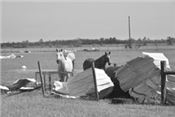|
Hurricane Damage Causes Problems For Louisiana Cattle, Poultry Producers

Horses in a pasture near Holmwood after Hurricane Laura. Debris like this is scattered throughout the area, and fencing is
down in numerous locations allowing livestock to get out of pasture and create a hazard on roadways.
Photo by Bruce Schultz/LSU AgCenter
LAKE CHARLES, LA.
Cattle producers in southwest Louisiana parishes are struggling to overcome the obstacles created by Hurricane Laura.
Jimmy Meaux, LSU AgCenter agent in Calcasieu Parish, said hay and fencing donations have been arriving but more is needed. Temporary pastures and corrals for cattle hauled from Cameron Parish are getting crowded. “We’re trying to find more staging areas.”
He said watering cattle has been helped with rainfall, but pumps for wells in pastures can’t be used because there’s no electricity. “Some just need a generator to run their wells.”
Meaux said damaged fences are common throughout the area. “In some places, fences are laid over for miles.”
Without fences, he said, cattle have been getting out of pastures and creating a hazard on roads, especially at night.
Meaux said his home is badly damaged, with trees and an awning on his roof. But he said his colleague, Bradley Pousson, LSU AgCenter county agent in Cameron Parish, has a bigger problem. “His house was destroyed where he was living in Carlyss. It’s gone. He’s working with no place to live.”
Pousson said he’s been working at what’s left of his house, along with his parents’ and grandmother’s house, and he’s staying with a friend.
Pousson said trees and power lines have knocked down fences. Trees can be cut, but removing power lines can only be done by utility companies, he said. “There’s a lot of damage everywhere.”
Vince Deshotel, LSU AgCenter regional livestock specialist, said cattle confined in small holding areas are starting to show signs of stress made worse by the heat and increasing insect populations. He said mosquito spraying by airplane is being conducted in Cameron Parish.
Adam Habetz, a rice and cattle farmer near Carlyss, said his fences have been ruined and will have to be replaced. “The fences are a mess. There’s no patching it.”
Habetz said he’s heard it could take six weeks or longer for power to be restored.
Jeffrey Boudreaux, of Holmwood, said his Angus cattle survived the storm OK, but one of his hay barns was ripped apart and the other was blown away, leaving round bales of Bermudagrass hay exposed to the weather. “I just cut that hay.”
Boudreaux moved to the Holmwood area after Hurricane Rita destroyed his home in Creole. His home had only minor damage this time. “I’ve got about six families staying with me.”
He said he’s learned that storm damage can be overcome. “It (a hurricane) can take everything I’ve got. It’s my family I’m worried about.”
Kyle LeBoeuf, a cattle producer at Holmwood, said most of his cattle are OK. “I had some in Creole that got lost.”
The roof on half of his house was torn away, and a horse barn was destroyed. His herd behind his house was OK.
This was the second time he’s had a house destroyed by a hurricane. Rita blew away his original home in Creole. “We lost everything.”
After the storm, his family and friends were trying to get a water pump working and get an ice machine running.
His neighbor, Blake Primeaux, said he rode out Laura in a nearby building. “You could feel the cinderblock walls breathing. When the roof would go up, the doors would open, and you could feel the wall breathe.”
Primeaux said all of his 25 cattle and home are OK, but his sheds were demolished and the roof on his home was damaged.
The problems caused by Laura weren’t limited to southwest Louisiana, or to cattle producers. Jason Holmes, LSU AgCenter agent based in Lincoln Parish, said storm damage to the poultry industry was sporadic, with part of the roofs of a few chicken houses blown away. “It was just isolated spots here and there.”
He estimated 40,000 to 50,000 birds died, and more have perished since the storm passed. Holmes explained that chicken mortality is the result of widespread power outages in north Louisiana where poultry producers are based, and they are having to rely on standby generators to power their cooling systems in the chicken houses.
The generators were not intended to run for several consecutive days, so they’re now having mechanical problems that lead to shutdowns. Cooling systems don’t work without electricity, Holmes said, and birds start dying within a few minutes. He said it’s currently difficult to get a total on that mortality figure.
Holmes said poultry producers are aware that their friends to the south are in even more dire straits. “They do feel blessed. They are worn out and tired but when they see and feel and hear about their friends down south, they feel bad for them.”
He said trees are damaged throughout north Louisiana. “Everywhere you go, there’s oak trees down.”
Holmes observed that Laura first struck the largest livestock producing parishes in coastal south Louisiana, then made its way north to big cattle- and poultry-producing parishes before turning northeast to hit the other poultry region. “It gave a good pounding to the entire livestock industry.” ∆
|
|